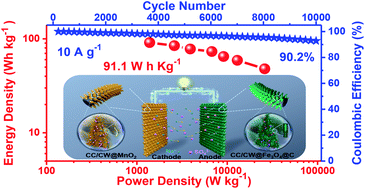Construction of a hierarchical carbon coated Fe3O4 nanorod anode for 2.6 V aqueous asymmetric supercapacitors with ultrahigh energy density†
Abstract
The low potential window and specific capacitances of aqueous asymmetric supercapacitors (ASCs) seriously restrict further improvement in energy density. Herein, a novel hierarchical nanowall structured carbon coated Fe3O4 nanorod growth on carbon cloth (CC/CW/Fe3O4@C) was fabricated as the anode. Benefitting from the ultrathin carbon protection layer and uniquely hierarchical structure, the CC/CW/Fe3O4@C anode exhibits an extended operating voltage from −1.3 to 0 V (vs. Ag/AgCl), significantly enhanced specific capacitance (463 F g−1 at 1 A g−1), remarkable rate capability (309 F g−1 at 50 A g−1) and superior cycle performance. To complement the wide potential anode, MnO2 nanowire arrays were similarly prepared as the cathode (CC/CW/MnO2) with outstanding capacitive performance. Remarkably, the assembled aqueous CC/CW/Fe3O4@C//CC/CW/MnO2 ASCs operate in a stable and wide potential window of 2.6 V with an ultrahigh energy density of 91.1 W h kg−1 along with extraordinary rate capability and cycle performance (92.8% retention after 10 000 cycles), surpassing most of the previously reported ASCs. This work provides a novel avenue to design and explore wide-voltage and high-capacity aqueous ASCs with further enhanced energy density.



 Please wait while we load your content...
Please wait while we load your content...